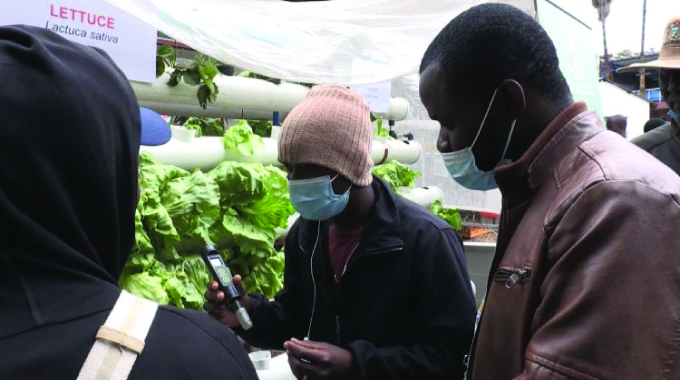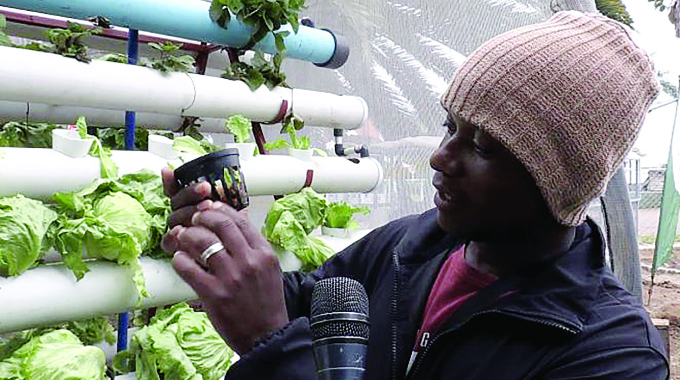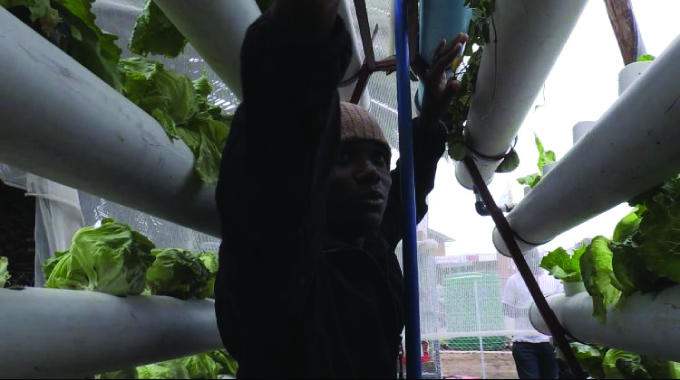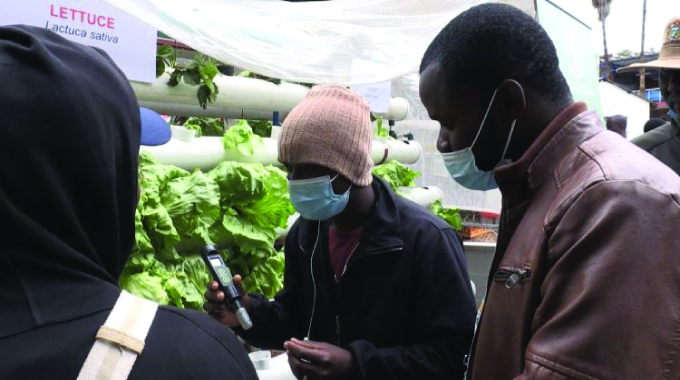
The Sunday News

Judith Phiri, Features Reporter
GROWING UP, Phathisani Vundla (28) never entertained the idea of venturing into crop agriculture.
He loathed the hard labour associated with land tilling and dirt from the soil.
He grew up knowing that one needs land, fertile soil and suitable climatic conditions to grow crops but he admits it was before he was exposed to other farming techniques.
Now Vundla is using hydroponics to grow vegetables such as lettuce and other horticultural crops on a backyard in Sizinda and he is living off the produce.

Phathisani Vundla demonstrates how the electical conduct (EC) meter works
“l always had the idea that for you to farm you need space and a farm but hydroponics opened my eyes to another way of farming.
I’m actually utilising the small backyard space that l have and making a living out of it in a short space of time.
The market is good as most people want organic foods.
There is always a market for healthy foods and something new,” he said.
Hydroponics is the practice of growing plants in nutrient solutions without the use of soil while it has the advantage of conserving water because it is recirculated and reused.
Hydroponics is the latest in the line of advanced farming techniques.
It involves growing plants, vegetables and fruits in water that is mixed with solutions containing all the nutrients required for the development of a plant in the absence of soil or sunlight.
Vundla attended a hydroponics training programme in Harare last year in November, with five other people from Bulawayo.
“I make about US$400 a month from my 416-plant system per harvest and a harvest can range from four to six weeks,” said Vundla as he showed some of his lettuce crop.
With the money he acquired from poultry farming, he channeled his profits to get an A-frame structure to do hydroponics.
Despite limited space in his backyard, and the shortage of water in most urban areas in Zimbabwe, Vundla runs a thriving hydroponic farm.
“Hydroponics farming is highly profitable.
It is an example of high yield on a small piece of land in any season or weather condition.
The hydroponics vegetables are highly nutritious and balanced in fibres, minerals, and vitamins.

Phathisani Vundla holds one of the cups used in hydroponics farming
It is the first method of doing soil-less farming/cultivation,” he explained.
Vundla said the method comes with a lot of benefits that include being an ecofriendly and smart way of farming.
“We are maximising space in order to get volumes in small spaces and products from hydroponics are very healthy.
This is because we are using purely organic materials, we are not using any artificial nutrients.
We make our own nutrients by using rabbit droppings, chicken droppings, moringa, maize hair, banana leaves and peels among others.
We mix these for thermal composting and the residue produced is the one we then use for cropping,” added Vundla.
Demonstrating how it’s done, he took a bucket of key ingredients which had fermented for over two days and he separated the liquid from the ingredients and put it in water.
“So, each and every crop has its own electrical conduct (EC) of the plant so we have to check it.
Our EC meter will tell us if it’s conducive to add it (nutrients liquid) into our system.

Phathisani Vundla, a hydroponics farmer
Our system should be circulating all the times to oxygenate the water.
So, we have our water reservoir down there with a pump that is going to pump the water up there to the plants.
Then we are going to use gravity to take the water back to our reservoir.
By doing this we are saving water and we use about 10 litres of water per week on this system so it’s very much ecofriendly,” said Vundla.
He said the other advantage of hydroponics was that the crops take less time to grow compared to farming on the soil.
Vundla said the method was also labour free.
“You just wake up in the morning and check your EC and potential hydrogen (ph) then you go about your business so this is one of the ways of smart farming.
The other thing is we are producing volumes in tiny spaces, especially for us who stay in a high-density suburb where space is a challenge.”
Vundla said people were very keen to take up products from hydroponics.
“I do urge people to take up hydroponics because it is healthy and smart way of farming, it’s ecofriendly.
This is a climate smart way of farming.”

The Ministry of Lands, Agriculture, Fisheries, Water and Rural Development working together with Danchurchaid (DCA), World Food Programme (WFP) and Agritex has been training urban farmers on the hydroponics farming system as part of efforts to build resilience among vulnerable communities.
Agricultural extension officer for Bulawayo Ms Treggie Mpofu, a horticultural specialist said using the different structures available for hydroponics, one could do leafy crops such as broccoli, rape, lettuce, tubers and bulb onions among others.
She said other structures could be used to crop fruit crops such as tomatoes and cucumber.
“In Bulawayo, Sizinda there are farmers between the age of 15 and 35, they received the training from the government and its partners.
We have got a multi-stakeholder forum where farmers, the partners and government work as a team to do sustainable agriculture.”
Commenting on Vundla’s project, she said on ground lettuce could take up to two to three months to grow but with hydroponics it took four to six weeks.
“The other crops could be much faster and can take up to three weeks, you harvest and sell them.
You can get your income within three to four weeks.
Your income generation is faster.
Within three months you could have sold three times,” added Ms Mpofu.
She said setting up a hydroponics structure costs around US$400, while the crops do not cost much.
“The income one gets is enough to sustain growth of their project as per every US$1 you spend you get about US$ 1.50 or more as your profit.”
She says the main advantage of the futuristic method is that it allows farmers to create farms in locations where soil conditions are too poor to support conventional farming
. Ms Mpofu noted that acclimate-controlled environment promotes year-round growth rather than waiting for the right season to grow particular plants.
“The method also ensures the farm can exist in places where weather and soil conditions are not favorable for traditional food production.”
Although not much of a new method, studies show that the earliest modern reference to hydroponics was by a man named William Frederick Gericke.
While working at the University of California, Berkeley, he began to popularise the idea that plants could be grown in a solution of nutrients and water instead of soil.



